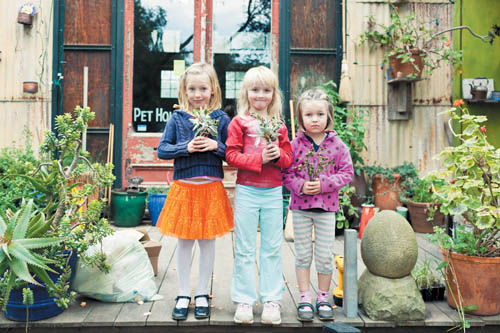7. Language That Liberates

It was high noon and the light was harsh at our local beachside park. As I was pushing my daughter on the swing, I noticed the swing-set structure provided about two feet of shade. I pushed the swing into the shaded area, and it became the perfect moment to capture those eyes that sparkle like the sun. For me, this image is a verse that says, “Whatever your age, wherever you go, you will always be my little sunshine...” and this picture is my proof.
Canon 5DMii, 50mm lens, f/5.6
READING A QUALITY BOOK is perhaps one of the most liberating and comforting acts. As the saying goes, there’s nothing like curling up with a good book. In a practical sense, reading is therapeutic—it helps us regain composure and calm down. Like huddling close to a fire on a rainy day, we curl up with books because words have the ability to soothe our soul and take us to a faraway land.
I have deep respect for novelists who understand the potential of descriptive verse and wield that power with the precision of a sword. It is stunning to me that novelists can create images that cut right to the core without any visual support. My favorite authors are those who use words to create mental images that are descriptive, resonant, and true. And they accomplish this without the crutch of having pictures on the page. Even in our mutual blindness, they open our eyes to new ways to see.
Language clearly affects how and what we see. Perhaps even more profound, language gives us a point of view that is out of the box. Rather than remaining stuck with life as it is, words help us imagine there is more.
Words as a Hidden Resource
As a photographer, if you pay attention to language, you will find a secret source for picture ideas. Consider these descriptions of the penguin from different authors that I found while visiting a zoo. The first one constructed an image of the penguin as “the best-dressed bird.” The second one created a more melancholy and empathetic tone. She described the penguin as “one of the only flightless birds.” As photographers, paying attention to such descriptive language can provide us with different visual images or photographic ideas. If ever I needed to go and photograph penguins in the wild, I would know where to start.
The first penguin description heightens our awareness of how a happy and well-dressed penguin appears. As a photographer you could use a zoom lens to capture a penguin on top of an iceberg waddling in his tuxedo suit. The second description draws our attention to how the penguin might feel. This idea could be photographically captured, by getting close and showing the penguin with wings open in wishful thought as he watches geese flying overhead.
The best language is a liberating force. It opens the zoo exhibit cage door so we can flap our wings. Whether photographing penguins or people, good language helps us to move beyond one-dimensional ideas. With language as a source, we can come up with more interesting and story-filled pictures.

This trio had just bought mistletoe at a local Christmas fair. We walked away from the event and I thought about how to capture a less literal Christmas portrait without a plastic Santa Claus or blinking lights. Then I spotted this artist’s house—the perfect setting.
Canon 5DMii, 35mm lens, f/4
Exercise: Making Descriptive Portraits
In creative writing literal and straightforward typically falls flat. A literal picture says too much too quickly and removes the mystery. In contrast, it’s the descriptive or figurative language that excites our mind. Rather than photographing someone directly, imagine you were taking a creative-writing class and make pictures that speak with a more descriptive and liberating voice.
Step 1 Descriptive Portrait Brainstorming
Set aside 15 minutes to generate portrait ideas based on creative descriptions or words. Try thinking about curious or clever ways to describe the type of people pictures you might want to make (see the exercise in Chapter 3). Or experiment with a literary device like metaphors or similes.
A metaphor is a figure of speech that says one thing equals a different thing. Here are a few examples: He is a pumpkin, she is my sunshine, and her home was a prison. A simile is a figure of speech that involves comparing one thing to another. For example: Your eyes are like the sun. His face is like a worn-out book. Her singing is like rain in the summertime.
Whatever method you choose (creative descriptive words, metaphor, or simile), write out a few ideas. Let the ideas flow without evaluation or critique. Get as many written down in 15 minutes as you can.
Tips
If you are having a hard time coming up with descriptive ideas, start by doing an online search for literary devices.
Generate ideas by doing an online search for topics like adjectives, clichés, idioms, metaphors, or similes. Or look up resources that provide information about how to write more powerful short stories, novels, or descriptive verse.
When photographing people try to get beyond surface descriptions like age, gender, height, and size. Try thinking about people in more figurative and descriptive ways. Doing this can help you see with new eyes.
Step 2 Selecting Your Favorite Ideas
Consider whom you would like to photograph and the pictures you would like to make. At this stage don’t worry about what the shot will actually look like; rather, focus on the concepts. Most importantly, have fun thinking about how you implement these ideas in order to make more descriptive pictures. With these details in mind, select the best five to ten ideas from the brainstorming. On a 4 by 5 index card or something similar, write down the ideas you liked most.
Step 3 Planning the Portraits
In a journal, sketch out a few locations and people you would like to photograph based on your favorite ideas. Choose between setting up photo shoots or just making casual pictures of people you know. If you’re interested in more formal pictures, contact the subject and set up a time to meet. For a more natural approach, just bring your camera with you and take pictures of people you know.
Exercise Details
Goal: 10 descriptive portraits. Tools: Camera; normal or telephoto focal-length lens. Light: Natural or available light. Location: Your choice. Theme: Creating portraits inspired by a creative use of words. Duration: Ten minutes per photo shoot.
Step 4 Implementing Your Ideas
For the photo shoot, keep your gear simple and pack just a camera and one lens. Bring the 4 by 5 index card with your favorite descriptive ideas in your pocket. Before the shoot, take a few minutes to review the ideas. Use them as internal guiding principles to influence the type of pictures you will make and to try to bring them to life. As you are photographing the subject, let go and get beyond the literal to more descriptive ideas.

ABOVE World traveler and adventurer, Martyn Hoffman, looks back without regret—arms crossed and feet firmly planted on the shifting sands—at an important crossroads in his life.
Canon 5DMii, 70–200mm lens, f/9
Keep the photo shoot short and to the point. Try to work in a nimble and agile way rather than forcing something that isn’t there. After a few minutes of shooting thank the subject for his time.
Step 5 Adding Value with Captions
After the photo shoot, select your favorite ten portraits and make small prints. Set the prints out on your desk and let them sit there for a few days. Then take a few minutes to come up with captions for each frame. A good caption is like a bonus, providing the viewer with inside information that makes the photograph an even more delightful experience. Limit the captions to a few words or a short phrase. Write the captions underneath the printed pictures and share them with a few colleagues or friends. Ask them for any further feedback or ideas.
OPPOSITE Douglas Kirkland is a legendary photographer, who has created iconic images of everyone from Marilyn Monroe, to Michael Jackson, to Angelina Jolie. This recent portrait captures how I see him—humble, quiet, and relaxed. In the garage of his Hollywood hills home, I asked him to turn his back to the opening of the garage, which created a bright and white scene. There is an ethereal element to this picture—a way of tipping my hat to the beautiful pcitures he has made.
Canon 5DMii, 85mm lens, f/1.2
“I don’t have a defined style, but what you do see in my portraits is that I’m connected to my subjects. You can’t be afraid to look someone in the eye and get to know who they really are.”
—Douglas Kirkland

